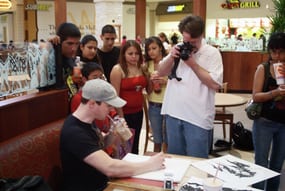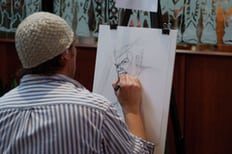When you are learning to draw comic art, you are taking the steps to express yourself in a unique art form. In it, you can explore potential scenarios that may happen and determine how you would proceed with them. You could even learn more about a certain area and focus on a personal growth while giving yourself the chance to reduce overall stress and build a collection of your own work.
Many people believe that comic art is broken down into two different forms. You have those that believe the comic book heroes are the true form of comic art, while others believe the comics in the Sunday paper are truer to the art form. In both cases what is being displayed would be considered correct.
That’s because there are no boundaries in terms of what is right or wrong. What is essential is that you find your passion in drawing what makes you feel something. If you want to lose yourself in an action comic, then you should focus your talents there. But if your passion is to make a person laugh then that is correct as well. The point is to make it about you.
If illustrations have been your passion for awhile now, and comic books leave you in awe, you are likely wondering what the process is to draw comics yourself. While it may seem intimidating at first, drawing comic art is like anything and you’ll get better with education and practice.
Be Inspired, Get Examples

– Favorite comic artist’s sketches, his/her cover art works or a particular comic issue that really gets to you the first time you saw it. When you are reviewing them notice the texture and shading that goes into giving each piece a unique feeling and look. On these pieces study the lines that go into each figure and object. There might be broken lines, or vibrant ones and you should note that each stroke is essential in the final product. When you are crafting a piece of your own, it is vital that you keep this in mind, and use it to enhance the level of work you put out.
From the selection that you have chosen to review, take a moment and find an area on that picture that strikes you. It could be something as simple as the face of a character or the brick pattern on the wall. Once you have decided on the perfect area, draw it yourself three times. The first drawing will be the same image in size comparison. This will help you to focus on areas on a standard scale. The second drawing should be in half the size. This process has you focus in on areas that are essential when it comes to detail. Finally, make a larger size of the original drawing to learn how detail works and provide practice in a larger scale.
Learn And Be Creative
Once you have completed this process you will then need to learn all about motion. This is where guidebooks and wooden human models come in handy because a drawing is inanimate you need to add portions to your drawing that lead the person reviewing your comic to believe that there is action. From a running motion to a powerful punch there are techniques you can do to achieve the feeling of action.
When you reach the point that you want to begin your own comic there are things to remember. Drawing comic art right the first time isn’t likely. You will make many changes as you fine tune your art and finally settle on a scene that works for you. With that in mind always start your drawings with a pencil on inexpensive paper. You can always transfer to higher quality paper after you have fine tuned the drawing by transposing the image.
The characters you draw will be an essential part of your own work. Think for a moment how many characters you want to have interacting and list their unique traits so you can make for a believable tale. Have a sample sketch of each waiting for you to add to the scenes that you are building. Even better, have a portfolio of characters designs, building, machines and other things as well so that you have a collection of your ideas that you might forget in the future.
Where is it?
It is important to keep in mind that the first frame of your comic should setup the scene’s setting. This can be done by simply creating an area that is recognizable by most people. It can be anything from an alley to a graveyard depending on your genre. Keep in mind while crafting you need room for conversations as well, so don’t work about sections conversation bubbles will appear in.
And The Story Goes……?
A plot-line is essential when learning how to draw comics. If your plot line doesn’t make sense, or is confusing to the reader,your art becomes overshadowed by the story. Think about the chain of events that will happen when you are telling the tale, and fine tune it to the point where the images compliment the actual tale.Your storyline doesn’t have to be 30 pages long or so, you’re not comic artist (yet). Start small.Five to seven pages of your sketch should do just fine.Move on to inking, then work your way up.
During the process of drawing you should be using model lines to help you keep track of how your artwork is progressing. These tiny lines help you to keep the focal points the same from one drawing to the next, and allow for a cleaner more even look to the comic. At the end of the drawing process, you will need to erase these lines in an effort to remove the focus that the reader may have.
Last but absolutely not the least-
Practice, Practice, Practice
When you first start drawing anything at all, ever got the feeling that nothing seems to go right? you tried to draw a horse but ends up looking like a dog? tried to do Superman but ends up with a not-so good Wonder Woman? Worry not, because it happens to everyone. Seriously, you can’t expect to draw a great looking piece of art the first time you tried, right? Practicing will sharpen your drawing skills naturally. If you’ve done any sketches, you’ll notice that as you progress your sketch art start will get better and you will end up liking your more recent sketches. Take a look at the history of a professional comic artists’ sketches, they practiced, learned and improved.
Submit your review | |

